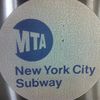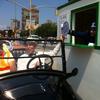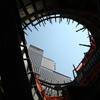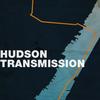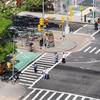Jim O'Grady appears in the following:
Walder's Time as MTA Chief Marked by Fiscal Discipline, Unfinished Business
Thursday, July 21, 2011

Metropolitan Transportation Authority chairman Jay Walder abruptly announced his resignation Thursday after just two years into his six-year term — and though he was considered a shrewd fiscal disciplinarian his departure comes as many important developments hang in the balance, from completion of mega-projects like the Second Avenue subway to an impending contract negotiation with a major union.
What Would Have Happened if East River Bridge Tolls Were Still in Effect?
Wednesday, July 20, 2011
Former NYC traffic commissioner Sam Schwartz hands a symbolic 1911 dime to a "toll taker" on the Manhattan side of the Williamsburg Bridge. (Photo by Jim O'Grady)
(New York, NY - WNYC) In the summery glare of a July morning, transportation advocates drove antique cars to a wooden toll booth they'd set up on the Manhattan side of the Williamsburg Bridge. Among them, in bow tie and straw hat, was former New York City traffic commissioner Sam Schwartz. He eased his roadster to the booth, stopped and pointedly proffered a dime to pay a toll that had been abolished 100 years ago to the day.
That was the last year anyone paid to cross the city's four East River Bridges. Schwartz and his allies in Transportation Alternatives and The Straphangers Campaign, say it's time that changed.
They said eliminating the tolls has cost the city $31 billion in inflation-adjusted revenue, part of which could've been used to maintain the Williamsburg Bridge.
"Every one of those steel beams is new," Schwartz said, gesturing toward the bridge, which underwent a top-to-bottom renovation lasting more than a decade and finishing not long ago.
Those new beams on the Williamsburg Bridge replaced old ones that had become so corroded by the 1980s, the city closed the bridge down. At the same time, the Manhattan Bridge was shaky enough that trains were prevented from crossing it. On the Brooklyn Bridge, a cable snapped and killed a tourist.
It was only then that the city paid for repairs to all of the East River Bridges.
Schwartz says if bridge tolls hadn't been discontinued by Mayor William Gaynor in 1911, who thought the dime payment was too much of a burden, the city would have had enough money for bridge maintenance and major infrastructure projects like the Second Avenue subway.
East River Bridge tolls met their most recent defeat in 2009, when then Lt. Governor Richard Ravitch proposed a bailout plan for the financially strapped NY MTA that included East River bridge tolls and a tax on employers in the suburban counties surrounding New York. Ravitch argued that it makes no sense that some East River's crossings collect tolls--like the Midtown Tunnel and the Robert F. Kennedy Bridge (formerly the Triborough Bridge)--while the Queensboro, Willamsburg, Brooklyn, and Manhattan Bridges do not.
But his plan met stiff opposition in the then-Democratically-controlled State Senate. Rather than bailing out the MTA, senators argued that the MTA was too wasteful to justify a bridge toll hike. In the end, the legislature rejected Ravitch's toll proposal, much as it rejected congestion-pricing a year earlier. Elected officials, like Mayor Gaynor a century before them, saw no reason to burden drivers.
Governor Andrew Cuomo has shown little predilection to support additional fees for drivers (check out his remarks against congestion pricing during the campaign) and the Republican State Senate hasn't either. The see as their constituency men like the driver of a dark blue late-model American car, who was in too much of a hurry to give his name as he waited for the light to turn and cross the Williamsburg Bridge to Brooklyn. Through his rolled-down window, he said: "No, no, no, no. No tolls. None. None whatsoever."
He was feet away from the vintage automobiles and advocates demonstrating for a return of the tolls. But on policy, as befits the divide between drivers and transit riders, he was miles apart.
Lamenting the Loss of East River Tolls, Advocates Hearken Back to Days of Yore
Tuesday, July 19, 2011

WiFi And Dial-tones Coming to NYC Subway Platforms...S l o w l y
Tuesday, July 19, 2011
(Photo by AZY_NYC / Flickr)
(New York, NY - WNYC) WiFi is coming to NYC subway platforms, but not for another four years -- and there will be no connectivity in tunnels.
The subway station project was delayed for nearly three years while Transit Wireless, the company chosen to set up the system at no cost to the NY MTA, got its financing in order. The authority's board selected the company in 2007 but didn't give it a "notice to proceed" until Broadcast Australia decided to back the company in July 2010.
New York City straphangers are of two minds about the lack of WiFi and cell phone service in the subway. They see it as either a galling void or a sanctuary from modern life's near-constant connectivity.
There's something for both sides in the NY Metropolitan Transportation Authority's current project to bring the internet and phone use underground. For those who want the service because it'll help emergency responders communicate and help riders use transit apps on their mobile devices--or because they absolutely MUST check their emails or headlines--they'll have it at three stations by the end of the year.
For those who don't want to hear a stranger discuss his grocery list at high volume, it'll be a full four years before the system's remaining 271 platforms are wirelessly enabled.
First to see the service will be the platforms, stairs and mezzanines of the 14th Street stations at 8th and 6th Avenues and the 23rd Street C / E station in Manhattan.
Transit Wireless will charge telecom companies for use of the wireless signal and then split the profits with the MTA. The authority says it expects to earn at least $30 million dollars over ten years from the deal.
The NY MTA also says there will be WiFi and cell phone service in a non-subway tunnel -- on its Metro-North commuter line between 97th Street and Grand Central Terminal, and in the terminal itself. The authority wouldn't give a completion date for that project.
NY MTA spokesman Aaron Donovan said the main benefit would be improved safety on platforms. “We send out real-time email, text message and Twitter alerts to our customers in the event of an emergency or other service disruption,” he said. “Having cell service in our underground platforms expands the reach and usefulness of those alerts.”
NYC DOT Says New Sensor System Will Help Move Midtown Traffic
Monday, July 18, 2011
Mayor Bloomberg and NYC DOT Commissioner Janette Sadik-Khan and Administrator of the Federal Highway Administration Victor Mendez unveil Midtown Moving at the city's Traffic Control Center in Queens. (Photo by Jim O'Grady)
(New York, NY - WNYC) Midtown traffic jams can now be eased with the touch of a button. That's what New York City officials promised as they introduced new traffic cameras, E-Z Pass readers and microwave motion sensors to 23 Manhattan intersections.
Mayor Bloomberg and Transportation Commissioner Janette Sadik-Khan unveiled the new system at the city's Traffic Control Center in Queens, where information gathered by the sensors is wirelessly transmitted. Mayor Bloomberg explained that traffic engineers can use it to spot congestion choke points and then: "They can sit there and touch buttons to turn a light green quicker, leave it on green quicker, leave it off green quicker, whatever the case may be."
The system is called Midtown in Motion. It covers about 110 square blocks, from Second to Sixth Avenues and from 42nd to 57th streets. The area is equally famous as a global business center and a grid that acts on weekdays like a glue trap for traffic. Sadik-Khan even cracked that to reach certain locations in Midtown during rush hour "you have to be born there."
Mayor Bloomberg said chronic traffic congestion costs the city's economy $13 billion a year for things like extra time needed to make deliveries.
That's a problem the Mayor previously tried to solve through congestion pricing, which was supposed to reduce the number of vehicles on the streets and ease traffic jams by assessing motorists a fee for entering parts of Manhattan during peak times. But the program failed to gain support in New York State's legislature. "Who knows whether the legislature is ever going to approve congestion pricing," Mayor Bloomberg said today, before noting that the traffic flow system that just went online could be used for congestion pricing, should its political fortunes reverse.
He said the new technology will give engineers the ability to respond quickly to "crashes, construction, special events like the UN General Assembly and times when congestion saturates the network, causing backups that block cross streets and crosswalks." Previously, traffic signals only could be set to preset signal patterns based on the time of day.
The program also involves the installation of new turn lanes at 53 intersections. Mayor Bloomberg said if Midtown in Motion is successful, the system will be spread by 2013 to the rest of New York's 12,500 signalized intersections, half of which are already digitized and integrated with the traffic management center.
The real-time traffic flow information will also be made available to motorists and to app developers for use on mobile devices. The project cost $1.6 million, with $600,000 coming from the Federal Highway Administration.
City Says New Sensor System Will Help Move Midtown Traffic
Monday, July 18, 2011
Midtown traffic jams can now be eased with the touch of a button, according to city officials who hope a battery of new traffic cameras, E-Z Pass readers and microwave motion sensors installed at 23 Manhattan intersections will help prevent congestion.
Reconstructed Fulton Transit Center, Partly Damaged on 9/11, Starts Opening
Wednesday, July 13, 2011
Looking up from below-ground through the frame of partially built oculus tower at the Fulton Transit Center. (Photo by Stephen Nessen / WNYC.)
(New York, NY - WNYC) At one time it was hoped that the $1.4 billion expansion and reconstruction of the Fulton Street Transit Center, partly damaged in the 9/11 terrorist attacks, would be done by the tenth anniversary of that day. That won't happen. But steady progress is being made on the much-delayed project, including the scheduled opening in the next two months of a new entrance and restoration of service to a closed portion of the Cortlandt Street station next to Ground Zero.
The sprawling underground complex is Lower Manhattan's primary transit crossroads. It has long been known as a good place to connect to different subway lines--if you can figure out how to do it. The center is a multi-leveled labyrinth connecting previously private subway systems not built to be compatible. A primary thrust of the project is to detangle it.
Workers prepare stairways for new tiles. (Photo by Stephen Nessen/WNYC)
To show how that was going, the New York Metropolitan Transportation Authority invited a WNYC reporter to don a hard hat and take an escorted look at the busy underground construction site.
It's an organized mess.
Shadowy caverns contain patches of muck and puddles that workers wearing reflective vests splash through. Cement mixers turn lazily as heavy metal blasts from a boombox.
Parts of the complex are impressive. The new Dey Street underpass will connect the center's main entrance building, which is a block south of City Hall Park, with the World Trade Center. It's a huge tunnel that the MTA says will be lined with digital screens showing train information, ads and artwork. That's a big change from what the Fulton Street station has always been: dark, cramped and crowded.
New tile work under construction. (Photo by Stephen Nessen/WNYC)
The grandest element is a fifty-foot glass tower over the main entrance that is to be topped by an oculus--a set of prisms to deflect natural light down to some of the subway platforms. The MTA seriously considered scrapping the tower in 2008 when the project went over budget. Then along came the federal stimulus and the tower was restored.
It was weirdly pleasing to stand two stories the street level on a future subway platform and look up through the steel framework of a tapered tower and see, above the high top of a construction crane, clouds scudding against blue sky.
When the center is all done and linked up with a station for the PATH Train to New Jersey under the World Trade Center--some time in 2016--visitors will be able to walk underground from the Winter Garden on the edge of the Hudson River to the William Street subway stop, about six blocks from South Street Seaport on the East River. That's about three-quarters of a mile.
The PATH Train to NJ is this way. (Photo by Stephen Nessen/WNYC)
Riders will have access to eleven subway lines, same as before. But the MTA says the warren of poorly lit passageways will be more open and straightforward. There should be less crowding and more space for the 300,000 people they expect to move through the Fulton Street Transit Center every weekday. That'll be a good day for downtown Manhattan, where 85 percent of all trips are made by mass transit, many of them using the center.
The project, begun in 2004, has been notorious for delays. Michael Horodniceanu, president of capital construction for the MTA, said part of the problem was the complexity of a task like building new station space under and around the 123 year-old Corbin Building, a nine-story landmark made of brick that will be incorporated into the main entrance. Horodniceanu said the Corbin Building's foundation had to be disassembled and rebuilt without using heavy machinery.
"It was done the old-fashioned way with a pick and shovel," he said. "People went down 30, 40 feet with buckets pulling out stuff. Then we filled it with concrete."
Old brick work uncovered during renovations beneath the Corbin Building on Broadway. (Photo by Stephen Nessen/WNYC)
And he said management of the project was flawed at the start. The MTA looked for a company to do every part of the enormous renovation on tight deadlines. Only one company bid and, when it got the job, soon started falling behind. Horodniceanu said when he came into his position in 2008, he broke the project up into parts, set what he called "realistic" deadlines and attracted multiple bidders.
Now the project seems on track. The MTA's part of it should be done by 2014.
To see more photos in a vivid slideshow of the project, go to WNYC.
Look | Sneak Peek at the Fulton Street Transit Center
Tuesday, July 12, 2011
NY Transit Museum Seeks Artifacts To Mark Grand Central Terminal's 100th Birthday
Monday, July 11, 2011
(Photo by: MightyBoyBrian / Flickr creative commons)
(New York, NY - WNYC) Grand Central Terminal's 100th birthday is eighteen months away. But The New York Transit Museum is putting the word out now that it's looking for memorabilia to mark the event.
NY Metropolitan Transportation Authority spokeswoman Marjorie Anders says the museum has many artifacts from New York's bus and subway systems but relatively few from Grand Central Terminal and its trains. That's because old lines like Conrail and Penn Central are either defunct or have been merged into Metro-North.
"The stuff that we're interested in displaying is from an era that's gone," she said. "It's from railroads that no longer exist."
Anders says the museum is seeking anything from a conductor's cap to a baggage cart. But it's especially interested in remnants from the middle of last century, when train travel was more elegant. In those days, Grand Central Terminal had rocking chairs in its ladies rooms and potted palms in its waiting areas. And passengers arriving on The 2oth Century Limited from Los Angeles stepped off the train onto a red carpet.
Anders says current and former workers who may have helped themselves to old railroad items will be forgiven--as long as they loan or donate them to the exhibit.
That includes Harry Kelly, who has worked at Grand Central for 38 years. In the 1970s and 80s, he updated arrival times on the terminal's sign boards using information sent to him from a dispatcher via telautograph machine. The dispatcher wrote with a pen that sent a signal through a telephone line and moved a pen across a sheet of paper in Kelly's office--like an early fax machine.
Then came computers to do that job. Kelly recalls that after that, a supervisor called him in and said, "Harry, do me a favor. Get rid of these old telautographs." Kelly tossed out about thirty of the devices before it hit him: "I'm not a big collector but this was something that I used for many, many years. So I held onto one."
Kelly will be loaning the salvaged machine to the exhibit.
Museum Seeks Artifacts From Golden Era to Mark Grand Central Terminal's 100th Birthday
Monday, July 11, 2011

Photo Contest Bares Best and Worst of NYC Subways and Buses
Friday, July 08, 2011
A gleaming silver subway train streaked with early morning light ...
The winning entry: "Break of Day" by Sabina Porter.
...to a puddle of apparently toxic scum on a platform at a Canal Street station. The two photos (including the top, winning entry, and nine other finalists, culled from 314 hopefuls) were sent in as part of a photo contest sponsored by New York City advocacy groups Straphangers Campaign and Transportation Alternatives.
"#sludge@canal" by Lucas Romero
One photo confirmed Susan Sontag's observation in On Photography that our image-saturated world puts us in "chronic voyeuristic relation" to others, like this tender young couple:
"Private moment" by Joshua Gross.
And with those who are ready to pose:
"Self-Expression Underground" by Joanna Oltman Smith.
Then again, living in a city means coming across strangers having a personal moment in public. And sometimes that person is us. Should that moment involve some kind of danger underground, here's hoping your life-line is better equipped than this one:
"Reassuring? Not so much!" by John Wehmeyer.
The contest proved that to see weird or even lovely stuff on a commute, all you need do is look around. Then whip out a camera-phone, assuming there's room enough on platform or train to raise the arms and shoot.
"Disruptions, Service Change, Fare Hikes, It's NYC MTA" by Carlos Sabater.
The two winners each received a 30-day unlimited MetroCard, that they might spend more time in the phantasmagoria that is the city's transportation system.
Neither NY MTA Nor NYC Eager To Pay For Trans-Hudson Power Cable
Friday, July 01, 2011
Schematic for a new power cable to New York City. (Photo by Hudson Transmission Partners)
(New York, NY - WNYC) The New York Metropolitan Transportation Authority and the City of New York--the two largest energy users in the Northeast--are balking at a request by the New York Power Authority for help in building an $850 million transmission cable under the Hudson River.
The transit agency, for one, doesn't think the payments are worth it.
The Power Authority asked the MTA to invest $64 million dollars to get the cable up and running. But, according to MTA documents, the agency determined it would probably never get that money back. That's because the Power Authority would have to break even on the project before reimbursing its governmental customers. And the officials even doubted the Power Authority's claim that the cable will lower the MTA's energy costs.
The MTA board tabled the matter in May. A spokesman says there are no plans to raise it again.
The Power Authority also asked New York City for an investment. But budget director Mark Page has said those talks have been at a standstill since April.
The Power Authority is a state agency that acquires energy for large governmental customers like the city, the MTA, the Port Authority of New York/New Jersey, and the New York City Housing Authority. It has asked the last two agencies to invest in the cable as well; no word on whether they've agreed.
The authority can't compel these government customers to pay out for the cable over 20 years, as it has asked of the MTA. Even so, it insists that negotiations to do just that are continuing. An authority spokesman said construction of the cable has officially begun, but would not say whether the project would be halted if the MTA and the others don't pony up the money.
The 14-mile cable, which would carry 660 megawatts from New Jersey to Midtown Manhattan, is scheduled for completion in 2013. It will be the first time the city is connected to energy sources west of the Hudson River.
Neither MTA Nor NYC Eager To Pay For Trans-Hudson Power Cable
Thursday, June 30, 2011

The MTA and the city of New York — the two largest energy users in the Northeast — are balking at a request by the New York Power Authority for help in building an $850 million transmission cable under the Hudson River.
Major NYC Bridge to Undergo 15-Year Repair Job
Thursday, June 30, 2011
RFK (Triborough Bridge) at night. (Photo by smith_c19 / Flickr)
(New York, NY - WNYC) The RFK Bridge, formerly known as the Triborough, is shaped like a "Y" with a very long tail because it connects three boroughs of New York City: Manhattan, Queens and the Bronx. It opened to traffic during the Great Depression--75 years ago this month--and was the first bridge in the city designed exclusively for the automobile.
Now the old girl is feeling her age. Or for gender balance, the old boy has the engineering equivalent of rickets.
On Friday, a 15-year repair job will commence on numerous parts of the bridge: decks, ramps, roadbeds and more. Initial work on the $1 billion project will remove concrete around the Manhattan toll plaza and replace it with rubberized asphalt designed to slow water erosion and give drivers a smoother ride.
After Labor Day, the Harlem River Drive's southbound ramp onto the bridge at 125th Street will be taken down and replaced. The NY Metropolitan Transportation Authority, which operates the bridge, will erect a detour ramp until the new ramp opens at the end of the year.
The RFK Bridge carries an average of 170,000 vehicles per day. It is actually a complex of three long-span bridges, several smaller bridges, a viaduct, parks, administrative offices and 14 miles of approach roads.
Needless to say, drivers should expect lane closures, changes to traffic patterns and late night work crews laboring under lights bright enough to land an alien spaceship. (Should that occur, let Transportation Nation be the first to welcome our merciful overlords.)
Final Day for a Free East River Ferry
Friday, June 24, 2011

The final day of free rides on the new East River Ferry is Friday.
[UPDATED] NY Legislature Passes Transit Lock Box Bill
Thursday, June 23, 2011
Weather-worn logo on the side of a subway train. (Photo by: Jim O'Grady)
We'll have an updated version of this post coming soon.
Updates at the bottom for now.
(New York, NY - WNYC) UPDATE APPENDED.
Right now, the collective gaze of the New York transit world is on Albany, where an extended session of the state legislature is frantically winding down. Transit watchers are waiting to learn the fate of a piece of legislation known as the "transit funding lockbox," which advocates say would bring stability to government funding streams that keep the buses, trains and subways running in and around New York City.
The bill passed the state Senate last night and is now in the hands of the state Assembly's Ways and Means Committee. Here's an official description of it, followed by an English translation:
"Prohibits diversion of resources from dedicated funds derived from taxes and fees that support the MTA, the NYC transit authority and their subsidiaries in certain instances."
That's addressed to past, present and future governors of New York. What it's saying, roughly, is no more raiding the NY MTA's budget to plug up state shortfalls.
The authority gets a crucial part of its revenues from a percentage of business and real estate taxes. Since 2009, as the recession reduced that income, the state took away an additional $260 million from those dedicated funds. The lockbox bill is designed to prevent that. Advocates say protecting NY MTA coffers will reduce the likelihood of a repeat of last year's painful fare increases and service cuts.
No wonder Transportation Nation's inbox is filled with emails from interested parties asking questions like: "Lockbox is key today...Anything from Cuomo?" Of course, that's New York Governor Andrew Cuomo, who will have the final say on whether the bill becomes law.
And now arrives this bristling email from a worried transit advocate, which we have permission to quote anonymously:
"We’re hearing that Cuomo is blocking the lockbox bill so that he can retain the ability to steal transit funds. (This is the same Cuomo who ran for governor last year on restoring honesty and ethics to government.)"
We've placed a call to the governor's office asking for his view on the bill. Check back for updates.
UPDATE 1. Now this from an advocate with a well-placed source on the legislative side: "Lockbox: sources say it should pass the Assembly tonight!" Still no word from the governor.
UPDATE 2. Michael Whyland, press secretary to Assembly Speaker Sheldon Silver, just called to say he expects the lockbox bill will be voted on tonight and that it will have "broad support." It already has 39 sponsors.
Then he added a ginormous caveat: If "suburban Republicans" use the introduction of the bill as an occasion to launch a debate about a payroll tax that is paid by their constituents in support of the NY MTA, that could be enough to "lay aside" the bill--that is, kill it. Whyland explained that with so much other major legislation awaiting votes on what is expected to be the last day of the session, the lockbox bill could be sacrificed to clear the decks for other priorities, like the gay marriage bill.
Whyland's bottom line: if the introduction of the lockbox bill doesn't spark a gridlock-inducing debate about the NY MTA payroll tax, it'll probably pass. Then comes Cuomo.
UPDATE 3. Whyland just called to say the bill has passed in the Assembly--statement from Speaker Sheldon Silver soon to come. We've asked Governor Cuomo, again, if he'll sign it. No answer yet.
Gov Cuomo To Decide Whether New York Gets "Complete Streets"
Tuesday, June 21, 2011
A "complete street" with space marked out not only for vehicles but pedestrians and bikes. (Photo by NYC DOT.)
(New York, NY - WNYC) New York State seems primed to gain more "complete" streets in the near future. A bill requiring transportation planners to consider pedestrian and bike-friendly features when building and redesigning roads passed in the New York State Assembly last night, after previously passing in the State Senate.
The bill now goes to Governor Cuomo, who is expected to sign it into law.
So-called 'complete streets' include not just space for vehicles but elements like bike lanes, pedestrian islands, countdown crosswalk signals and expanded curbs for people waiting to board a bus. The requirement would apply to roads built with state or federal money.
Nadine Lemmon, legislative advocate for the Tri-State Transportation Campaign, is using state statistics to lobby for the Governor's signature. "New York has some of the most dangerous roads in the nation," she said. "Over the last ten years, over 3,000 pedestrians have died on our roads and our research at Tri-State shows that one of the leading causes of these deaths is faulty road design."
Some highway superintendents complained about the cost of adding bike lanes and similar features to road projects. So the bill was changed in a late negotiation to require them in the design phase, while making their implementation optional if they'd put a project over budget. A town or county cannot be sued if it chooses not to install complete street features for budgetary reasons.
New York on the Road to Having More Pedestrian, Bike-Friendly Streets
Tuesday, June 21, 2011

Schumer: Use ARC Tunnel $ To Finish Digging Rail Tunnel Under East River
Monday, June 20, 2011
East Side Access would bring Long Island Railroad to Grand Central Station through a tunnel under the East River at 63rd Street and then beneath Park Avenue.
U.S. Senator Charles Schumer says New Jersey's transportation loss should be Long Island's gain.
The Senator is supporting a $2.2 billion low-interest loan from the federal government to the New York Metropolitan Transportation Authority. The money was originally earmarked for a commuter rail tunnel under the Hudson River that Governor Chris Christie killed in October. Schumer says it should now go to finishing East Side Access, a project connecting Long Island Railroad to Grand Central Station through tunnels beneath the East River. Long Island Railroad is the nation's largest commuter line.
East Side Access is supposed to be done by 2016, but is only funded through the end of the year. The project is designed to speed up trips for about 160,000 riders from Long Island to Manhattan's East Side by as much as 30 to 40 minutes.
More than $5 billion in state and federal funds have already been spent on the new rail connection, one of the largest infrastructure projects in the U.S. But East Side Access is still facing a $2.2 billion shortfall.
The MTA applied for the loan in late April to the Federal Railroad Administration, which is part of the U.S. Department of Transportation. Spokesman Aaron Donovan said the authority is "in discussions with the U.S. DOT as part of the application process but we don't have an estimate on when we'll hear back."
U.S. DOT spokeswoman Olivia Alair said "We do not have comment on this today."
Most Long Island Railroad trains cross under Manhattan to arrive at Penn Station on the West Side, adding to congestion at that station and forcing commuters with jobs on the East Side to double back by bus or subway. Schumer said eliminating that bottleneck and adding flexibility to the system will "boost New York as the economic engine of the region."
More $ For Bus Drivers Will Mean Fewer Deadly Crashes: Report
Friday, June 17, 2011
 (New York, NY WNYC) The Amalgamated Transit Union says it has an antidote to the recent plague of deadly long distance bus crashes: pay drivers overtime. The report contends that would limit drivers' hours behind the wheel, reducing the time buses are operated in a state of fatigue, which is the leading cause of accidents.
(New York, NY WNYC) The Amalgamated Transit Union says it has an antidote to the recent plague of deadly long distance bus crashes: pay drivers overtime. The report contends that would limit drivers' hours behind the wheel, reducing the time buses are operated in a state of fatigue, which is the leading cause of accidents.
The report looks at statistics produced by National Traffic Safety Board investigations of 16 fatal bus crashes between June 1998 and January 2008:
Driver related problems were responsible for 60 percent of the fatalities occurring in the crashes investigated, while the condition of the vehicle accounted for only 20 percent of the fatalities. Driver fatigue was responsible for a staggering 36% of the fatalities occurring in the crashes investigated. It was the number one cause of fatal accidents, far above road conditions (2%) and inattention (6%). Other than vehicle condition, the next highest root cause was driver medical condition (18%).
The Virginia State Police believe driver fatigue caused a long distance bus to overturn on I-95 in Virginia on May 31. That accident killed four passengers and injured more than 50 others. It was the sixth major bus crash since the beginning of the year.
Those accidents, and the 25 fatalities they've produced, have prompted federal regulators to call for greater inspection powers of operators in the fast-growing industry. It has also brought renewed attention to the Motorcoach Safety Enhancement Act of 2011, which would require long distance buses to be fitted with seat belts, crush-proof roofs, reinforced windows and anti-roll technology.
All well and good, says the ATU report, but none of those measures directly address the issue of driver fatigue:
Hours of service regulations that have been in existence for decades are routinely ignored, especially by fly-by-night, non-union bus companies. The state police in general do not perform random checks of passenger buses the way they do on cargo-hauling trucks because of the dissatisfaction expressed by passengers when their bus gets pulled out of commission and no replacement vehicle arrives for hours. Moreover, even if police actively
seek out so-called discount bus carriers, there are not nearly enough law enforcement officers to even begin the process of ridding the highways of unsafe buses.
America Bus Association spokesman Dan Ronan disagreed with union's conclusion that bus company owners should give up their federal exemption from having to pay drivers overtime.
"This exemption has been around since the 1930s and we’ve had this series of accidents in the last month or so but we’ve gone 80 years without a rash of accidents," he said. "So if overtime pay were an issue, you would’ve thought we’d have had this level of accidents all the time, not just in the last couple of weeks here."
He said operators who pay substandard wages are not going to obey a law requiring overtime pay.
"The real question is how we get those guys off the road and reward the bus companies that are doing a good job, that are out there paying the drivers a decent wage, making sure their logbooks are up to date, that they’re driving safe equipment, all the things that make up a good bus company," he said.
